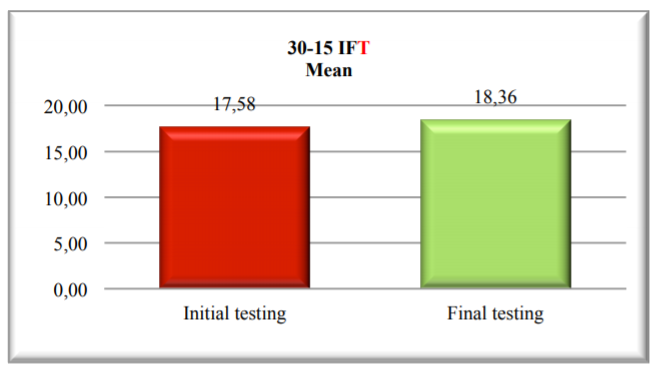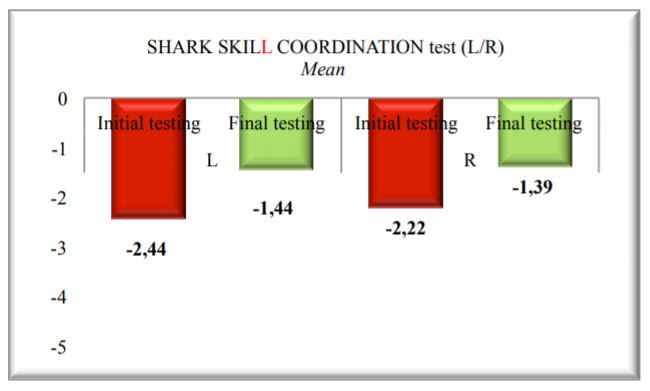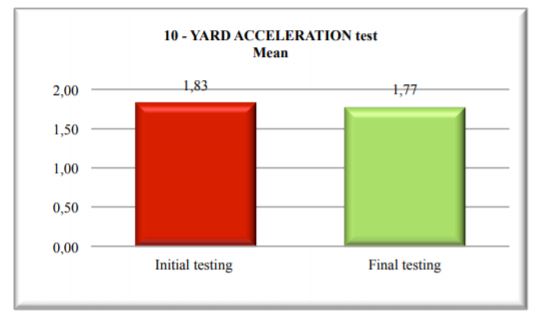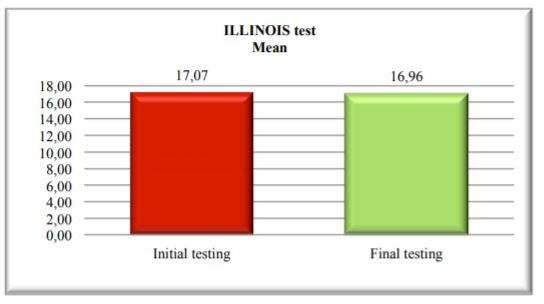Experimental Study for Improving the Physical Condition of Women Handball Players in the Preparatory Phase
Abstract
The aim of thisresearch was to highlight the effective implementation of a training program, suitable for the preparatory phase of a Romanian women’s handball team, CSM Bucharest. The physical tests applied to the players were chosen so that they could provide a wide range of information about the most important and necessary physical qualities of a handball player: acceleration speed, coordination, agility and endurance. The tests chosen for this research are: 10-yard acceleration test, Illinois test, Shark Skill Coordination test and 30-15 Intermittent Fitness Test (IFT). Based on the results obtained in these tests and also taking into consideration the preparatory phase specificity, we applied a 7-week physical and technical-tactical training program. At the end of this period, the tests were performed again. The differences recorded have shown considerable improvements in the effort capacity of the players, which confirms the effectiveness of planning and programming the training for this period.
Keywords: Handball, women, preparatory phase, effort capacity
Introduction
The preparatory phase finds its place in preseason and has a huge importance within a macrocycle,
since in this period the functional foundations for following performances have to be built. According
to the structure proposed by the Romanian Handball Federation, the competition year consists of 2
macrocycles. This study refers to the preparatory phase of the first macrocycle, from the beginning of
the competition year.
We aimed to choose the most modern and efficient training means and methods to develop motor
skills, such as acceleration speed, agility, coordination, strength, endurance, and to improve and
complete the handball-specific techniques or tactical preparation, according to psychological and motor
features of the players.
Materials and methods
Subjects
CSM Bucharest women’s handball team has a total of 19 players, and 18 of them have played in at
least 5 senior national championships. 16 team players were or are members of the youth or senior
national team for Romania, Brazil, Spain, Ukraine and Sweden. One player suffered a serious injury
during the training, so she could not be part of this research.
The preparatory phase was held in Bucharest, without mountain or sea training camps, in the period
between 7th July and 30th August. Handball and strength workouts took place at Apollo Hall, and
running training sessions, at Olympia stadium.
A set of 4 tests were applied to the players: 30-15 Intermittent Fitness Test (IFT) for endurance
(Buchheit et al., 2009), 10-yard acceleration test for speed (Tudor, 2013), Illinois test for agility
(Mackenzie, 2005) and Shark Skill test for coordination.
To interpret the results obtained in the physical tests, we used common scientific methods of
research, as bibliographic study, graphical representation, and statistical and mathematical calculation:
mean, standard deviation, coefficient of variation and mean error, all the formulas being used from the
second edition of Marian Popa’s book (2008).
Hypothesis of the research
Starting from the particularities of the general preparatory phase, the research has the following
hypothesis: The general and specific preparatory phase, which means around 50% of the workouts for
this period, leads to improvement of the effort capacity.
Structure and content of the preparatory phase
The research period contained 2 identical microcycles. The first type of microcycle was repeated 4
times, in the period 7th July to 7th August, for the general preparatory phase, and the second type of
microcycle, 3 times, in the period 7th August to 30th August, corresponding to the precompetitive phase.
The first type of microcycle has 5 days of preparation, followed by 2 resting and recovery days, at
the end of the week. A total of 9 training sessions were programmed for this microcycle: 2 sessions on
Monday, Tuesday, Thursday and Friday, for 90 minutes each, and only one session on Wednesday, for
120 minutes.
The second type of microcycle has 4 days of preparation and 2 days of preparation games. On
Monday, Tuesday, Thursday and Friday, there were planned two training sessions, while Wednesday
and Saturday were scheduled for games, and Sunday was free. Morning sessions lasted 60 minutes, and
evening sessions, 90 minutes.
Based on the type of training, morning sessions were scheduled for general physical preparation,
with the following objectives:
•Developing the aerobic capacity; •Increasing the functional capacity of the body; •Muscular hypertrophy; •Improving the strength endurance; •Creating and maintaining a strong motivation to sustain physical effort during the long and hard
competition year.
Evening sessions were scheduled for technical and tactical preparation and for improving specific
physical preparation (with the ball). The objectives for these training sessions are:
•Improving acceleration speed and velocity, agility, mobility, segmental coordination and balance: using the coordination ladder, cones, stepper or jumping rope, working circuits including exercises
that cover the entire range of handball-specific movements: stops, turns, jumps, defence movements,
changes of direction;
•Regaining handball-specific skills frequently used by the players, with a focus on the accuracy of these skills;
•Perfecting and consolidating handball skills, with a large volume and medium intensity (endurance); •Achieving homogeneity of the couples on the court; •Developing tactical thinking, along with educating the ability to quickly analyse the situations
created by the opponent;
•Consolidating the offence and defence phases.
“All exercises, with or without ball, have the characteristics of the preparatory phase: a large
volume of work, with medium to high intensity” (Dragnea, Căliman, & Cristea-Mic, 2012: 62).
To fulfil the objectives, the following means were used:
•Outdoor long-distance running: 35 min.: 5 min. 140-150 bpm, 20 min. 150-160 bpm, 5 min. 160-170 bpm, 5 min. 130-140 bpm;
•Outdoor interval running: 2×8×1min. (170-180bpm)/ 1min. active break; •Indoor speed endurance running: 3×12×30sec./30sec.; the 30 seconds of running have to complete 3
handball courts (40m each);
•A complex of short handball movements executed in high speed - 30 sec. work, 10 sec. break; •Series of 60-120 sec. handball game - 3:3, 4:4 or 5:5, without playing the ball from the middle line
after a scored goal, to eliminate the low intensity moments;
•A complex of exercises for developing coordination and balance, using the coordination ladder; •Exercises for consolidating the defence phases; •Wing - back, playmaker - line player, goalkeeper - middle defence player: against passive and active
defence, 2 against 2 play on different sections of the handball field;
•5-8 consecutive throws from each position of the handball field, without any breaks; •Combined circuit for strength development, 10-12 reps with 70% of 1RM; •Stretching exercises.
Results

From the initial to the final testing, as shown in Figure 1, the mean values showed a significant
increase of 0.87 units. According to Table 1, T-value was -3.831, and P-value was 0.001, p< 0.05. All
these results show that the research hypothesis is confirmed.
For both testing stages, the coefficient of variation has values that indicate high homogeneity of the
group (Table 1).
The mean error (M) has, for both testing stages, values smaller than the mean, which proves that
Mean (X) has a certain value, not a guiding value.

From the initial to the final testing, as shown in Figure 2, the results proved a significant increase of
1.00 unit for the left foot (t = -2.525, p = 0.022, p< 0.05) and 0.83 units for the right foot (t = -2.557, p
= 0.020, p< 0.05), which means that the research hypothesis is confirmed. The left foot results are
better than the right foot results. The reason might be that most of the players are right-handed, which
means that they habitually jump and use the left foot.
For both testing stages, as shown in Table 2, the coefficient of variation has values that indicate very
low homogeneity of the group (values above 35%).
The mean error (M) has, for both testing stages, values smaller than the mean, which proves that
Mean (X) has a certain value, not a guiding value.

Between the two testing stages, we can see a significant decrease in the mean results by 0.06 units (t
= 3.546, p = 0.002, p< 0.05), which shows us that the research hypothesis is confirmed.
Because the coefficient of variation has a value smaller than 15%, we can conclude that
homogeneity of the group is very high.
The mean error (M) has, for both testing stages, values smaller than the mean, which proves that
Mean (X) has a certain value, not a guiding value (Table 3 and Figure 3).

Between the two testing stages, we can see a significant decrease in the mean results by 0.11 units (t
= 2.338, p = 0.032, p< 0.05), which shows that the research hypothesis is confirmed. This can be also
seen in Table 4 and Figure 4 .
Because the coefficient of variation has values smaller than 15%, we can conclude that homogeneity
of the group is very high.
The mean error (M) has, for both testing stages, values smaller than the mean, which proves that
Mean (X) has a certain value, not a guiding value.
Discussions and conclusions
The physical testing proposed had a huge importance in setting the goals, methodology, training
content and preparation planning. The aim of proper planning based on the assessments was to obtain a
good shape of the body and mind for the most important moments of the championship. Following the
test results, we could make a real and accurate diagnosis of the physical ability of all team players, and
this was the first step in the preparation process in order to establish a proper plan, so that the players
could improve the most important aspects of physical preparation, in accordance with the preparatory
phase. The obtained results confirmed the effectiveness of the implemented training program, suitable
for the general preparatory phase.
For all 4 tests, the research hypothesis is confirmed. The players have achieved significant
improvements in all the important physical qualities: endurance, agility, coordination and acceleration
speed.
Acknowledgements
This paper is made and published under the aegis of the Research Institute for Quality of Life, Romanian Academy as a part of programme co-funded by the European Union within the Operational Sectoral Programme for Human Resources Development through the project for Pluri- and interdisciplinarity in doctoral and post-doctoral programmes, Project Code: POSDRU/159/1.5/S/141086.
References
Buchheit, M., Lepretre, P. M., Behaegel, A. L., Millet, G. P., Cuvelier, G., & Ahmaidi, S. (2009). Cardiorespiratory responses during running and sport-specific exercises in handball players. Journal of Science and Medicine in Sport, 12(3), 399-405.
Dragnea, A., Căliman, C., & Cristea-Mic, N. (2012). Orientarea metodică a pregătirii în handbal. București: CSM.
Mackenzie, B. (2005). 101 Performance Evaluation Tests. London: Electric Word.
Popa, M. (2008). Statistică pentru psihologie. Teorie și aplicații SPSS (Ed. a II-a). Iași: Polirom.
Tudor, V. (2013). Măsurare și evaluare în sport. București: Discobolul.
Copyright information

This work is licensed under a Creative Commons Attribution-NonCommercial-NoDerivatives 4.0 International License.
About this article
Publication Date
10 June 2016
Article Doi
eBook ISBN
978-1-80296-010-5
Publisher
Future Academy
Volume
11
Print ISBN (optional)
-
Edition Number
1st Edition
Pages
1-509
Subjects
Sports, sport science, physical education
Cite this article as:
Vărzaru, C. G. (2016). Experimental Study for Improving the Physical Condition of Women Handball Players in the Preparatory Phase . In V. Grigore, M. Stanescu, & M. Paunescu (Eds.), Physical Education, Sport and Kinetotherapy - ICPESK 2015, vol 11. European Proceedings of Social and Behavioural Sciences (pp. 416-422). Future Academy. https://doi.org/10.15405/epsbs.2016.06.58

